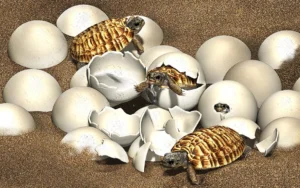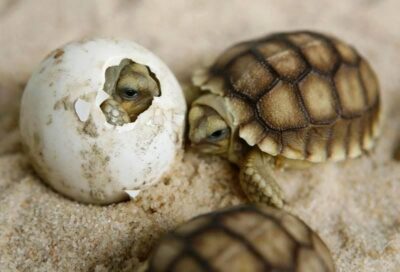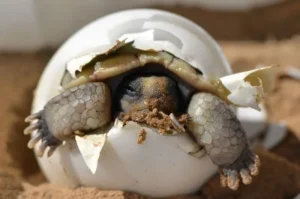The hatching process of box turtle eggs is a fascinating and intricate journey that begins with the embryo’s development within the egg and culminates in the emergence of the hatchling. Here’s an overview of the typical stages involved in the hatching process:
- Embryonic Development: After a female box turtle lays her eggs in a suitable nesting site, the eggs undergo embryonic development. During this period, the embryo develops from a fertilized egg into a fully formed hatchling. The duration of embryonic development varies depending on factors such as temperature, with warmer temperatures generally accelerating development.
- Pip Formation: As the embryo nears the end of its development, it starts to produce a specialized structure called the “pip.” The pip is a small, pointed projection on the eggshell created by the hatchling as it begins to break through the shell. This process typically occurs shortly before hatching and is often visible as a small crack or dent in the eggshell.
- Internal Pipping: Before external pipping occurs, the hatchling initiates internal pipping, which involves breaking through the inner membrane of the egg. This stage allows the hatchling to access air and prepares it for the final stages of hatching.
- External Pipping: External pipping is the stage where the hatchling breaks through the eggshell from the inside to the outside. Using a specialized structure called an “egg tooth” located on its snout, the hatchling carefully chips away at the eggshell until it creates a hole large enough to emerge.
- Hatching: Once the hatchling has created a sufficient opening in the eggshell, it begins to push its way out of the egg. This process requires strength and coordination, as the hatchling uses its limbs to push against the eggshell while gradually emerging from the confines of the egg.
- Emergence: After successfully breaking free from the eggshell, the hatchling emerges into the outside world. Initially, the hatchling may appear weak or disoriented, but it quickly adjusts to its surroundings. The hatchling’s shell is often soft and pliable at this stage, gradually hardening over time.
- Post-Hatching Care: After hatching, the hatchling may remain near the nest site for a period of time, allowing its shell to harden and its body to adjust to its new environment. In some cases, the hatchling may receive minimal parental care from the female before venturing off on its own.
Understanding the hatching process of box turtle eggs can provide valuable insights into the early stages of a hatchling’s life and help guide conservation efforts aimed at protecting these fascinating reptiles.
Tips for ensuring successful hatching
Ensuring successful hatching of box turtle eggs requires careful attention to environmental conditions and proper management techniques. Here are some tips to help promote successful hatching:
- Provide Optimal Incubation Conditions: Maintain stable environmental conditions within the incubation environment, including temperature and humidity levels. Use a reliable thermometer and hygrometer to monitor these parameters closely. For most box turtle species, incubation temperatures ranging from 75°F to 85°F (24°C to 29°C) and humidity levels around 80% are suitable.
- Use Suitable Substrate: Choose a suitable substrate for nesting, such as a mixture of soil, sand, and leaf litter. The substrate should be moisture-retentive but well-draining to prevent waterlogging and fungal growth. Ensure that the substrate depth allows for adequate burial of the eggs.
- Prevent Egg Rotation: Mimic natural nesting conditions by avoiding unnecessary disturbance to the eggs. Once the eggs are laid, refrain from rotating or moving them to prevent damage to the embryos. If artificial incubation is necessary, handle the eggs carefully and avoid excessive movement.
- Provide Adequate Ventilation: Ensure proper ventilation within the incubation container to prevent the buildup of harmful gases and maintain adequate oxygen levels. However, be cautious not to allow excessive airflow, which can lead to drying out of the eggs.
- Monitor Egg Health: Regularly inspect the eggs for signs of fungal growth, discoloration, or damage. Remove any visibly damaged or infertile eggs to prevent the spread of infection to healthy ones. Maintain cleanliness within the incubation environment to minimize the risk of contamination.
- Rotate Eggs Regularly: If using artificial incubation methods, gently rotate the eggs periodically to prevent the embryos from adhering to the eggshell. This helps ensure even development and reduces the risk of developmental abnormalities.
- Patience and Observation: Hatching can be a slow and gradual process, so exercise patience and avoid interfering unnecessarily. Monitor the eggs closely for signs of internal and external pipping, and be prepared to assist hatchlings that may experience difficulty emerging from the eggshell.
- Provide Post-Hatching Care: After hatching, provide a suitable rearing environment for the hatchlings, including proper temperature, humidity, and access to food and water. Monitor the hatchlings closely for any signs of health issues or abnormalities and seek veterinary care if necessary.
By implementing these tips and closely monitoring the incubation process, you can increase the likelihood of successful hatching and contribute to the conservation of box turtle populations.
Conclusion
How long does it take box turtle eggs to hatch? The duration of incubation for box turtle eggs varies depending on factors such as species, environmental conditions, and genetics. Generally, it can take around 60 to 90 days for Eastern Box Turtles and Three-toed Box Turtles, while Ornate Box Turtles may require 70 to 100 days.
Gulf Coast Box Turtles typically hatch within a similar timeframe as Eastern Box Turtles. Understanding and maintaining optimal incubation conditions, including temperature, humidity, and egg health, are crucial for ensuring successful hatching. By providing suitable nesting sites and carefully managing the incubation process, we can contribute to the conservation efforts aimed at protecting these remarkable reptiles.



